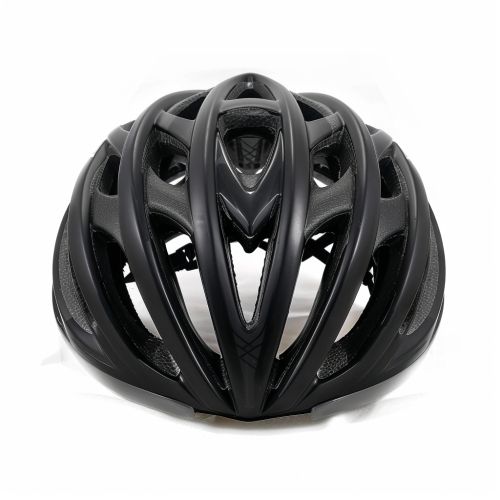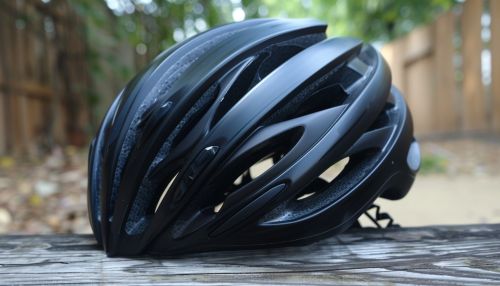Bicycle helmet
Introduction
A bicycle helmet is a form of protective gear worn to protect the head of cyclists in the event of a fall or collision. The primary purpose of a bicycle helmet is to reduce the risk of head injuries by absorbing the impact energy during an accident. Modern bicycle helmets are designed to be lightweight, comfortable, and aerodynamically efficient while providing maximum protection.
History
The concept of head protection for cyclists dates back to the late 19th century when early forms of helmets were made from heavy materials like leather. These early helmets were primarily used by racing cyclists. The development of modern bicycle helmets began in the 1970s with the introduction of expanded polystyrene (EPS) foam, which significantly improved the helmet's ability to absorb impact energy. The Snell Memorial Foundation and other organizations began setting safety standards for bicycle helmets, leading to widespread adoption and improvements in design and materials.
Design and Construction
Bicycle helmets are typically composed of three main components: the outer shell, the impact-absorbing liner, and the retention system.
Outer Shell
The outer shell is usually made from a hard plastic material such as polycarbonate. It serves to protect the EPS foam liner from abrasions and punctures and helps distribute impact forces over a larger area. The shell also provides a smooth surface to help the helmet slide on impact, reducing rotational forces on the head.
Impact-Absorbing Liner
The liner is the most critical component of a bicycle helmet. It is typically made from EPS foam, which compresses upon impact to absorb and dissipate energy. Some helmets use alternative materials like expanded polypropylene (EPP) or multi-density foams to enhance impact protection and durability.
Retention System
The retention system, commonly known as the strap system, secures the helmet to the cyclist's head. It usually consists of adjustable straps that go around the ears and under the chin, along with a buckle for fastening. Some helmets also feature a fit adjustment mechanism, such as a dial or ratchet system, to ensure a snug and secure fit.
Safety Standards and Certifications
Bicycle helmets must meet specific safety standards to be sold in various regions. These standards are set by organizations such as the Consumer Product Safety Commission (CPSC) in the United States, the European Committee for Standardization (CEN) in Europe, and the Snell Memorial Foundation. These standards specify the minimum performance requirements for impact protection, retention system strength, and coverage area.
Types of Bicycle Helmets
Different types of bicycle helmets are designed for various cycling disciplines and preferences.
Road Helmets
Road helmets are designed for use on paved surfaces and are optimized for aerodynamics, ventilation, and lightweight construction. They typically feature numerous vents to keep the rider cool and a streamlined shape to reduce air resistance.


Mountain Bike Helmets
Mountain bike helmets are designed for off-road cycling and provide additional coverage and protection. They often feature a more robust construction, extended rear coverage, and a visor to shield the rider's eyes from the sun and debris.
Commuter Helmets
Commuter helmets are designed for everyday use and urban cycling. They prioritize comfort, visibility, and ease of use. Some commuter helmets include integrated lights or reflective elements to enhance visibility in low-light conditions.
Full-Face Helmets
Full-face helmets provide maximum protection and are commonly used in downhill mountain biking and BMX racing. They feature a chin guard and a full-face shield to protect the rider's face and jaw in addition to the head.
Helmet Fit and Adjustment
Proper fit is crucial for a bicycle helmet to provide effective protection. A helmet should fit snugly on the head without being too tight. The front of the helmet should sit just above the eyebrows, and the straps should form a "V" shape around the ears. The chin strap should be adjusted so that it is snug but not uncomfortable, allowing the rider to open their mouth without restriction.
Advances in Helmet Technology
Recent advancements in bicycle helmet technology have focused on improving impact protection, comfort, and aerodynamics.
Multi-directional Impact Protection System (MIPS)
MIPS technology is designed to reduce rotational forces on the brain during an impact. It consists of a low-friction layer inside the helmet that allows the helmet to rotate slightly relative to the head, reducing the rotational forces transmitted to the brain.
WaveCel and Koroyd
WaveCel and Koroyd are alternative impact-absorbing materials used in some helmets. WaveCel is a collapsible cellular structure that absorbs impact energy through crumpling and sliding. Koroyd is made from a series of co-polymer tubes that crush uniformly on impact, providing consistent energy absorption.
Smart Helmets
Smart helmets incorporate technology such as integrated lights, communication systems, and sensors to enhance safety and convenience. Some smart helmets feature Bluetooth connectivity, allowing riders to make phone calls, listen to music, or receive navigation instructions without taking their hands off the handlebars.
Helmet Maintenance and Lifespan
Regular maintenance and inspection of a bicycle helmet are essential to ensure its effectiveness. Helmets should be checked for cracks, dents, or other signs of damage before each use. The retention system should be inspected for wear and proper function. Most manufacturers recommend replacing a helmet every 3-5 years or immediately after a significant impact, even if no visible damage is present.
Controversies and Debates
The use of bicycle helmets has been a subject of debate among cyclists, policymakers, and safety advocates. Some argue that mandatory helmet laws discourage cycling and that the overall health benefits of cycling outweigh the risks of head injuries. Others contend that helmets are essential for reducing the severity of head injuries and that mandatory helmet laws can save lives.
Conclusion
Bicycle helmets are a critical component of cycling safety, designed to protect riders from head injuries in the event of a fall or collision. Advances in materials and technology continue to improve the effectiveness and comfort of helmets, making them an essential piece of equipment for cyclists of all disciplines.
